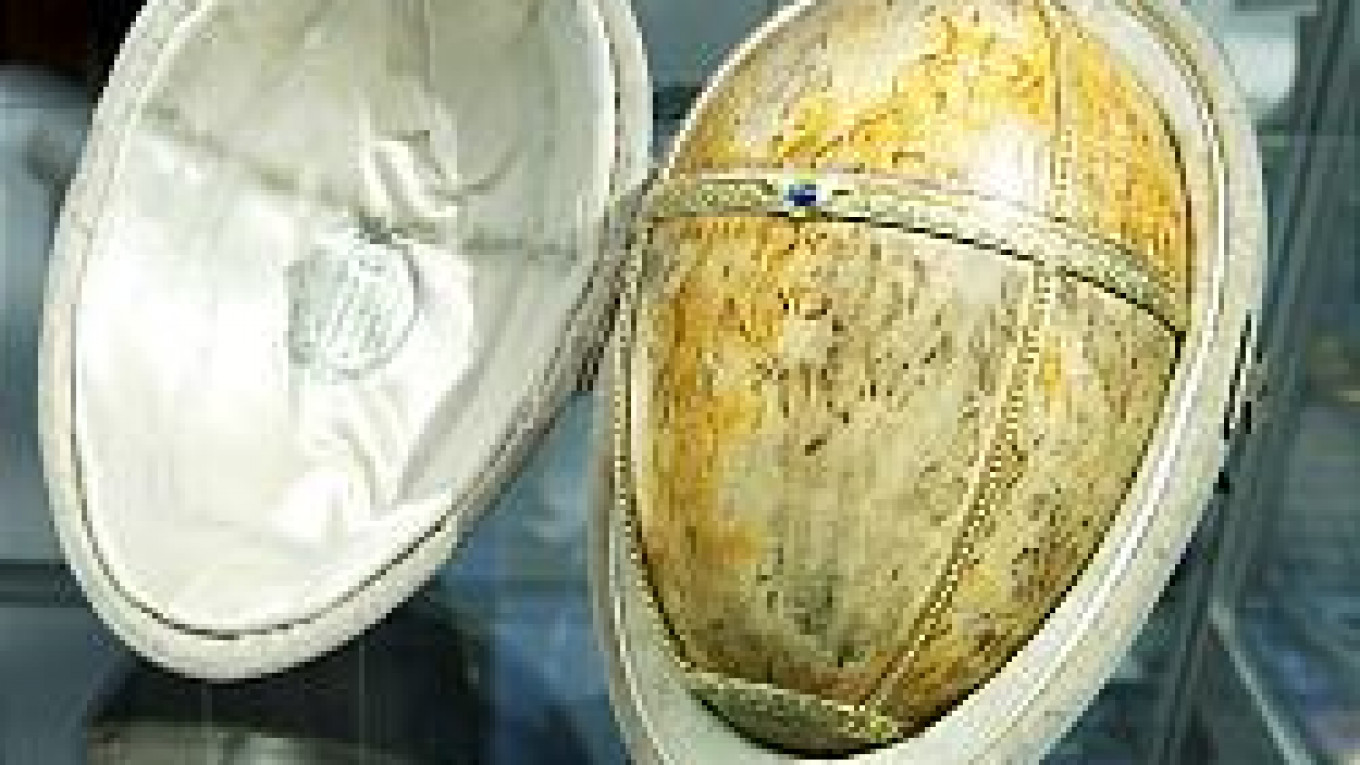The egg -- the last Easter decoration created for the family of Tsar Nicholas II by Carl Faberge's Petersburg shop and presented to the tsar's mother, Maria Fyodorevna, in March 1917 -- was purchased by the privately owned Russian National Museum last year and, before this week, had not been exhibited on its native soil since 1927. On Wednesday, it went on display with other late-tsarist decorative arts in a small case hidden behind myriad jewelry stands at Gostiny Dvor's second annual New Russian Style exhibit.
The show's main purpose is to provide a platform for jewelers to exhibit their wares before President-appointed specialists award the Kremlin Standard, which rewards excellence in jewelrymaking, decorative arts and related fields. Russian National Museum director Alexander Ivanov said the museum waited to display the egg until the jewelry show in order to inspire contemporary artisans with "a return to the traditions of Russia's past."
The museum purchased the egg last year after it emerged from nearly 85 years of obscurity in 2001. Ivanov declined to name the egg's previous owner -- who he said lives in London and is descended from a family of Russian emigres -- saying only that the egg cost the museum "millions of dollars." A Christie's Faberge expert in Russia, Valentin Skurlov, this week priced the egg at $2.5 to $3 million.
The sum is a hefty one considering the egg is made of Karelian birch rather than the usual gold and precious gems that made Faberge famous. The egg does not even contain Faberge's trademark surprise hidden inside -- anymore.
Because the downturn of Russian fortunes during World War I and the increasingly revolutionary mood in the country made it impolitic for the tsar to commission bejeweled Easter eggs after 1916, the egg was fashioned from birch and gold bands. Inside, though, Faberge crafted an expensive surprise: a mechanical elephant with eight large diamonds, 61 small diamonds and a diamond-studded key engraved "MF" -- for Maria Fyodorevna. The elephant has since been lost -- Skurlov said it was likely stolen by soldiers during the October Revolution.
Ivanov said it is the egg's history, rather than its physical composition, that makes it so valuable. Its purchase included the transfer of all of the egg's original documentation -- including the invoice from its sale and a letter from Faberge to transitional government head Alexander Kerensky. "The letter alone could cost ?100,000 because it is an original historical document," Ivanov said. In the letter, Faberge complains about having not been paid and asks Kerensky to send the egg to Nicholas II.
The February Revolution occurred just 32 days before Easter on April 1, 1917, and Nicholas II obtained the egg after paying 12,500 rubles ($6,000 at the time) -- despite having already abdicated.
The Rumyantsevsky Museum (now the Lenin Library) acquired the egg after the October Revolution. In January 1927, the museum closed and 450 items -- including the egg -- were sold by the Soviet government to foreign buyers. Experts can only speculate about the egg's whereabouts before it surfaced in London -- Ivanov suggested Turkey, Skurlov proposed Czechoslovakia.
In total, 42 imperial eggs were sold abroad in the late 1920s, and today 11 are housed in the Kremlin's Armory. The birch egg -- one of the 51 imperial eggs ever created and the first to resurface since 1961 -- will not join the others in the Armory: Its high price tag will see to that.
"Over the last 15 years, I have sold imperial eggs through Christie's," Skurlov said. "But not once was there a time when the Russian government and the Armory Palace had enough money to buy them."
The Russian National Museum, on the other hand, has a substantial budget raised through investments and antiques sales. "Our museum purchases a great deal from abroad -- at Sotheby's, at Christies," Ivanov said. "We're good buyers."
In 2002, a Faberge masterpiece, the Winter Egg, sold for $9.6 million -- a jump from the previous record sale price of $5.6 million in 1994 and $4,760 in 1949. Skurlov said the increasing rarity of Faberge eggs remaining on the market has caused prices to rise.
"No one who owns them wants to sell them and on the market there are no more than 10," he said. "They're very fashionable. They're the calling card of Russia."
New Russian Style runs through Saturday at Gostiny Dvor (4 Ilyinka Ulitsa. Metro Ploshchad Revolyutsii). The exhibit is open daily from 11 a.m. to 7 p.m. The egg will be on display in Munich from Nov. through Feb. 2004, after which it will return to the Russian National Museum (3 Pucheshnaya Ulitsa. Metro Kuznetsky Most. Tel. 921-4152.)
A Message from The Moscow Times:
Dear readers,
We are facing unprecedented challenges. Russia's Prosecutor General's Office has designated The Moscow Times as an "undesirable" organization, criminalizing our work and putting our staff at risk of prosecution. This follows our earlier unjust labeling as a "foreign agent."
These actions are direct attempts to silence independent journalism in Russia. The authorities claim our work "discredits the decisions of the Russian leadership." We see things differently: we strive to provide accurate, unbiased reporting on Russia.
We, the journalists of The Moscow Times, refuse to be silenced. But to continue our work, we need your help.
Your support, no matter how small, makes a world of difference. If you can, please support us monthly starting from just $2. It's quick to set up, and every contribution makes a significant impact.
By supporting The Moscow Times, you're defending open, independent journalism in the face of repression. Thank you for standing with us.
Remind me later.


